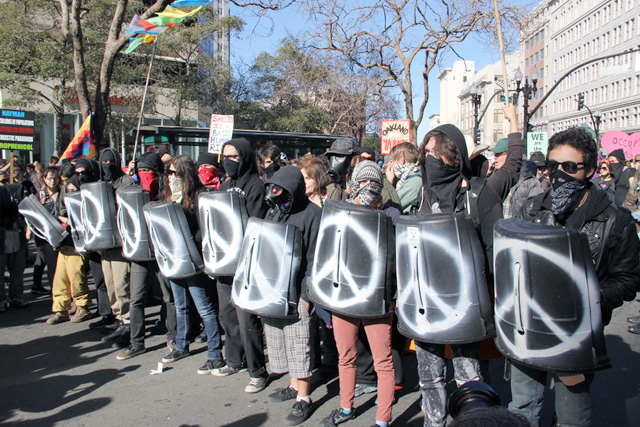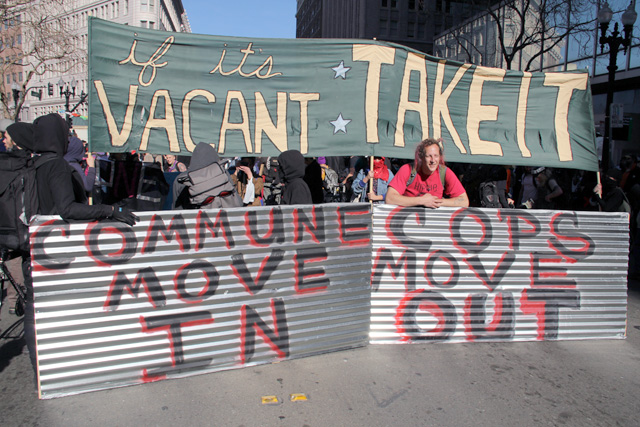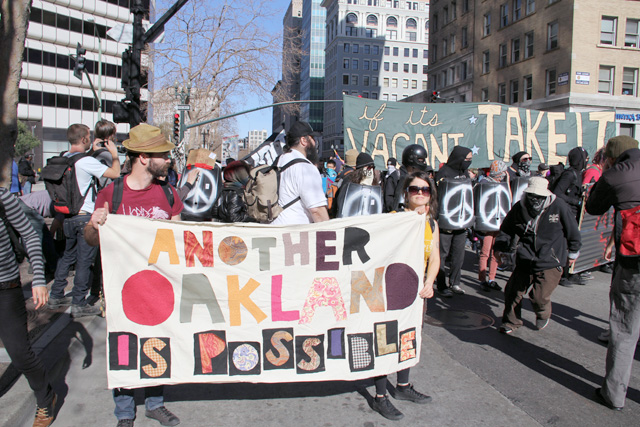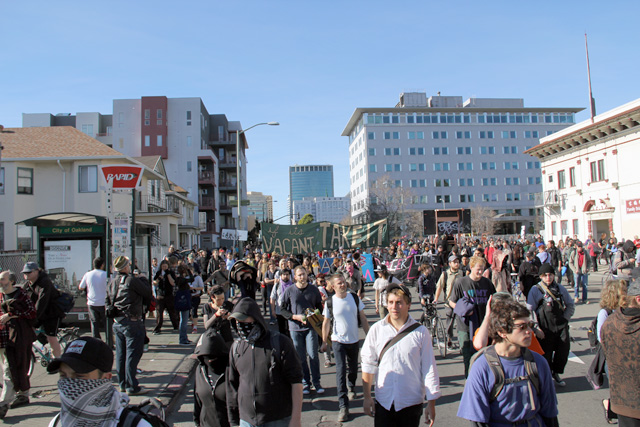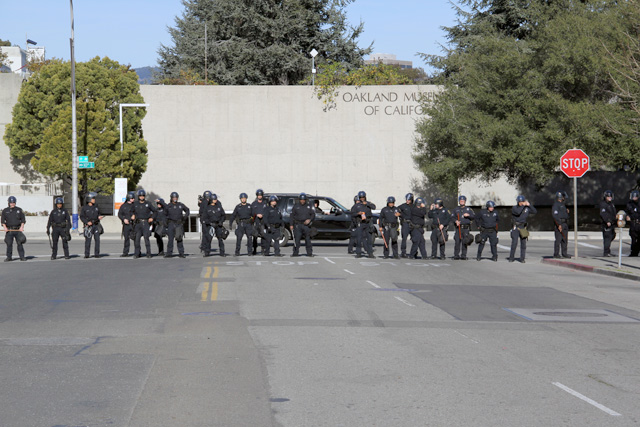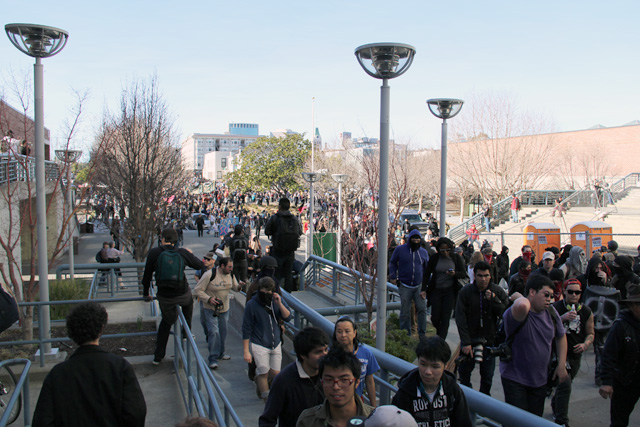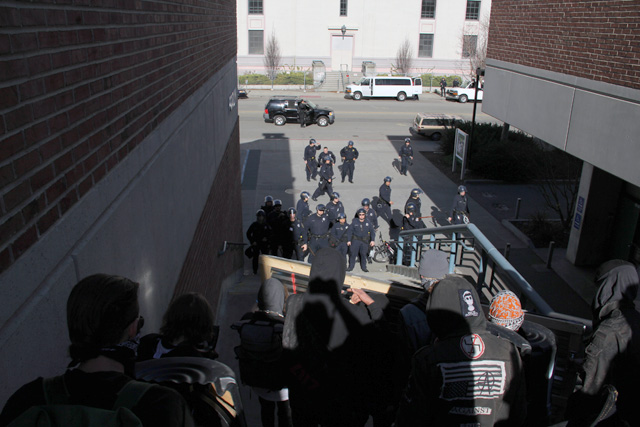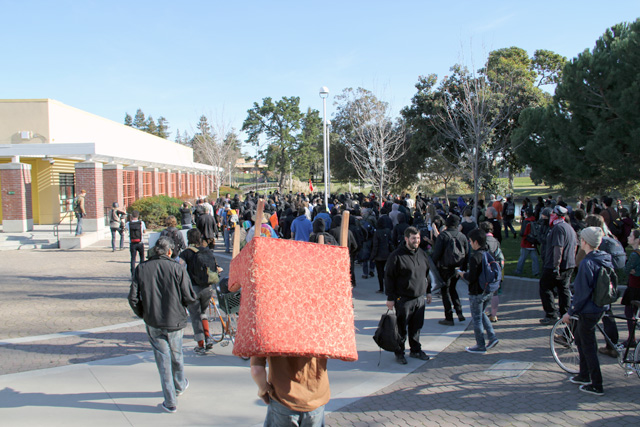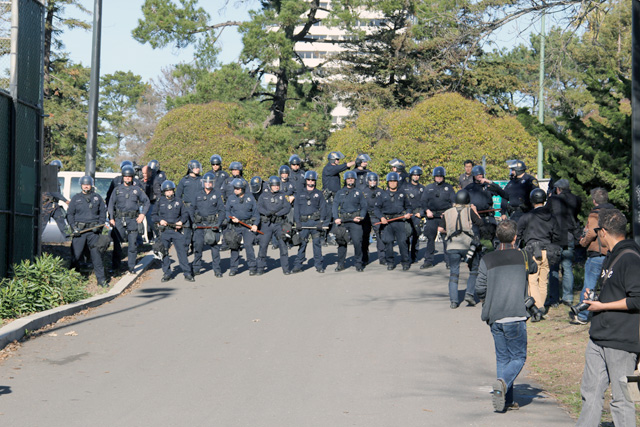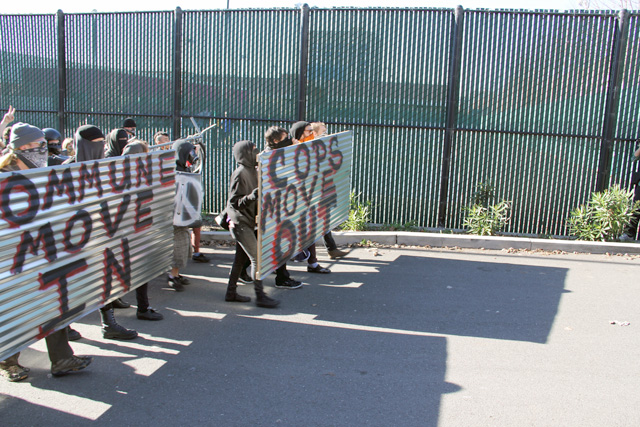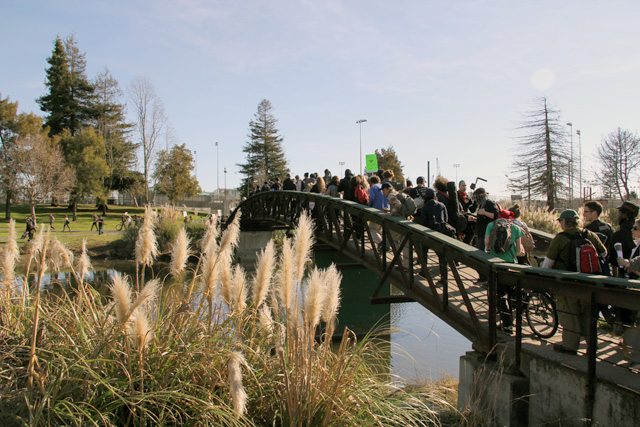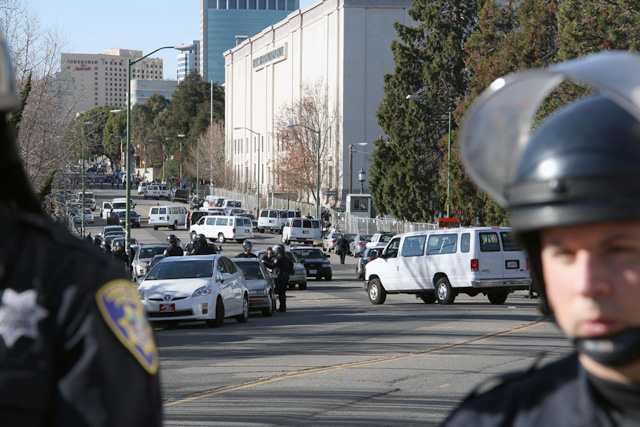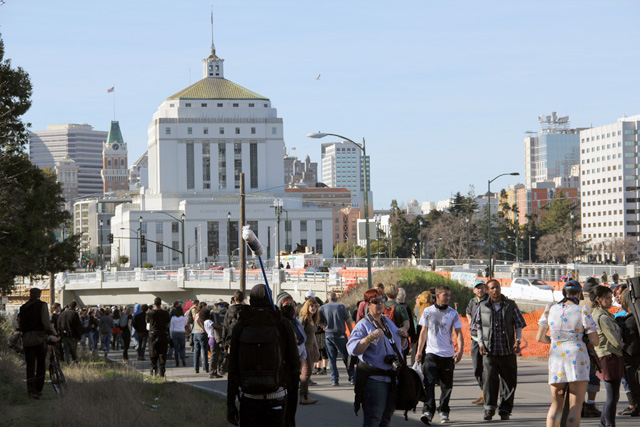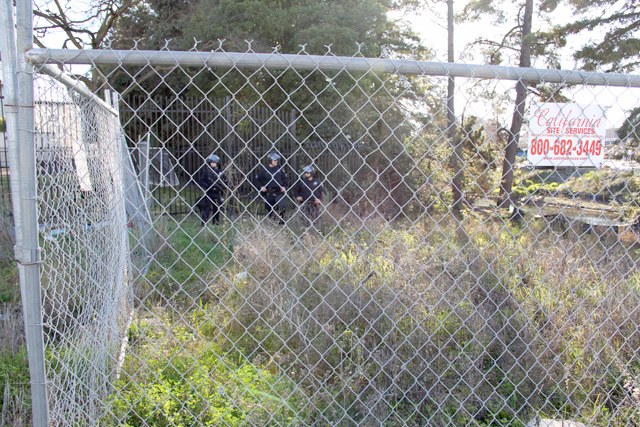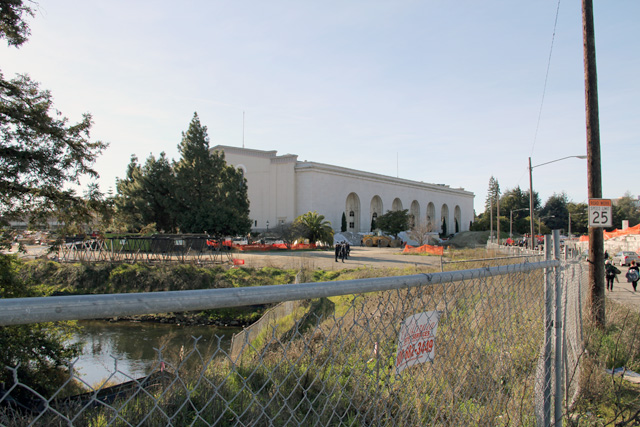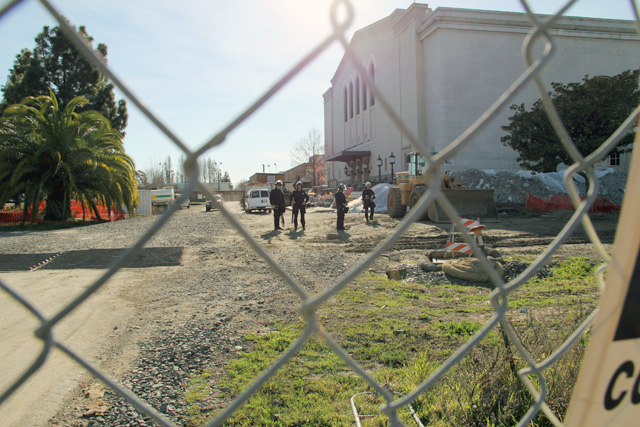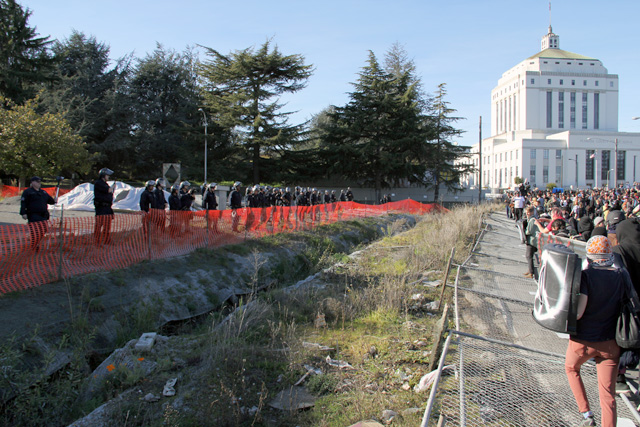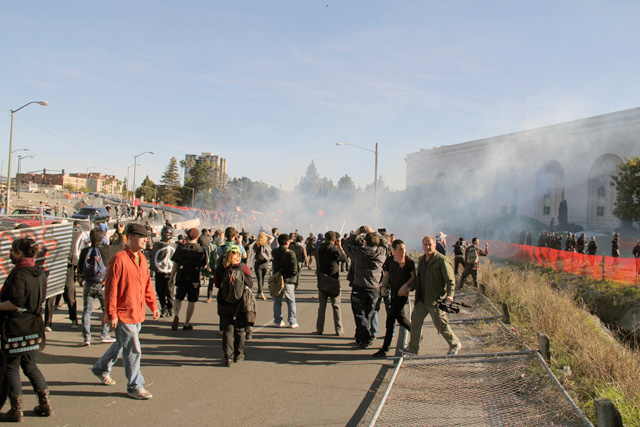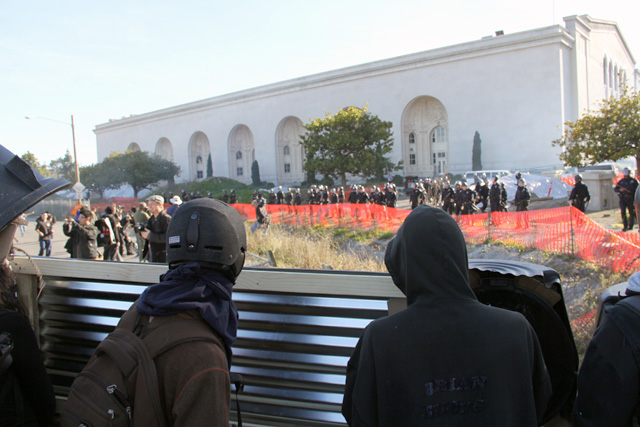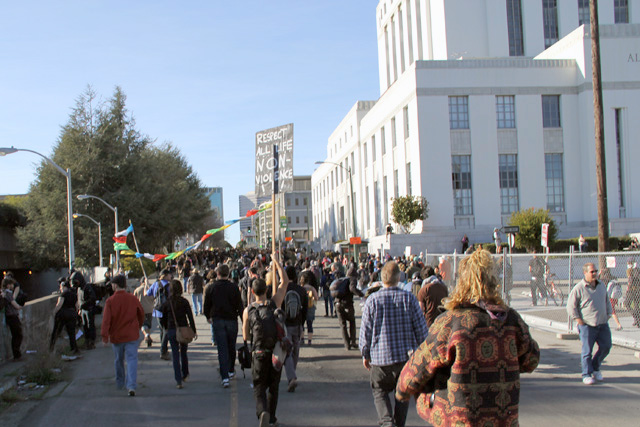From the Open-Publishing Calendar
From the Open-Publishing Newswire
Indybay Feature
Occupy Oakland Move-In Day - Henry J Plan A, 1/28/12: photos
Occupy Oakland had intended January 28th to be Move-In Day, that is a vacant building of a nature suitable to serve as a new indoor home for the occupation was to be reclaimed for public use. A weekend Rise Up Festival was scheduled to follow the successful occupation of an abandoned building. Several potential locations were selected by the Move-In Day Assembly, although they were not publicly announced. Plan "A" apparently was the Henry J Kaiser Convention Center, but Oakland police tracking and paralleling the Move-In Day march in a dozen or more large white vans full of riot police formed a line around the building preventing occupiers from entering the auditorium grounds. After circling the Henry J by passing through the Laney College campus, marchers stopped between Lake Merritt and the convention center. A free-standing chain-link perimeter fence was pulled over by demonstrators but no one attempted to cross the ditch in between the police line and marchers. Within a minute or two, police declared an illegal assembly and fired several volleys of tear gas at the crowd. Marchers headed toward downtown after giving up hope for converting the unused auditorium into a thriving community space.
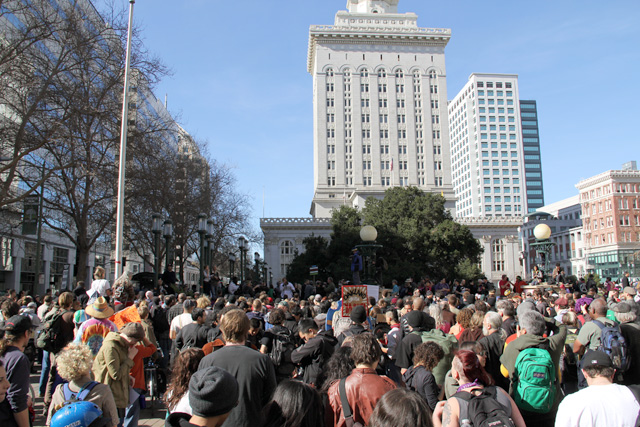
[Pictured above: City Hall looms behind the rally at Oscar Grant Plaza before the march to Plan A location]
It should be noted that the day started with a targeted arrest at noon on the 14th Street side of the plaza by City Hall before the rally began. The provocative snatch and arrest of a long-time Occupy Oakland participant who was violating no laws at the time riled up those who had already gathered at the plaza. Chants of "Let him go!" rained down on police as they took their bounty away. Police tried to form a line at the edge of the plaza to hold back the angry crowd, but were pulled away by an OPD commander who told the police line to withdraw and move across the street.
Henry J. Kaiser Convention Center: Located across from Laney College near Lake Merritt and the Estuary at 10 10th St Oakland, CA 94607 the Oakland Municipal Auditorium (a.k.a. The Henry J. Kaiser Convention Center) includes the 1,900 seat formal Calvin Simmons Theater, and a multi-purpose arena, which seats up to 4,500 people. The Oakland Municipal Auditorium was opened in 1914 has been used for everything from the provision of emergency medical services in the Flu pandemic of 1918, to Grateful Dead and Oakland Ballet performances to the Black Panther Party Black Community Survival Conference and the Green Party Presidential Campaign of Ralph Nader. Mayor Jerry Brown closed the auditorium in 2006, allegedly because of a slight operating deficit, but more likely in an attempt to set up the sale of the property in the booming real estate market of the time. The Convention Center was one of the few large venues staffed by Union workers and many labor unions and left political groups used the hall because it paid the workers decent wages. When Brown closed the hall 20 workers lost good paying union jobs and the community lost a locale for everything from high school graduations to AC/DC concerts. The supposed annual budget savings were $300,000 a year. (City staff recently estimated that in the intervening five years $5,000,000 to $9,000,000 worth of decay had occurred in the property.) Jobs, public service and economic stimulus of a vital downtown jewel were destroyed due to property speculation. (Even the City’s 1% were hurt — the Oakland Ballet which used the Calvin Simmons Theater in the Center became homeless and went out of business for over a year.) The property has been left largely vacant, except for some isolated event rentals since then. In 2011, in a paperwork shuffle the City of Oakland sold the property to its the Redevelopment agency (the City Council is the board of the Redevelopment Agency). http://www.tripadvisor.com/Attraction_Review-g32810-d1419402-Reviews-Henry_J_Kaiser_Convention_Center-Oakland_California.html
We The Planet 2004: "A Festival of Music and Activism" at the Henry J
http://www.indybay.org/newsitems/2004/11/11/26192.php
Occupy Oakland Move-In Day and Rise Up Festival Press Conference, 1/25/12: video & photos
http://www.indybay.org/newsitems/2012/01/25/18705617.php
Occupy Oakland Move-In Day Mural on San Pablo Ave
http://www.indybay.org/newsitems/2012/01/27/18705765.php
Move-In Day Assembly
http://occupyoaklandmoveinday.org
Occupy Oakland
http://www.occupyoakland.org
For more information:
It should be noted that the day started with a targeted arrest at noon on the 14th Street side of the plaza by City Hall before the rally began. The provocative snatch and arrest of a long-time Occupy Oakland participant who was violating no laws at the time riled up those who had already gathered at the plaza. Chants of "Let him go!" rained down on police as they took their bounty away. Police tried to form a line at the edge of the plaza to hold back the angry crowd, but were pulled away by an OPD commander who told the police line to withdraw and move across the street.
Henry J. Kaiser Convention Center: Located across from Laney College near Lake Merritt and the Estuary at 10 10th St Oakland, CA 94607 the Oakland Municipal Auditorium (a.k.a. The Henry J. Kaiser Convention Center) includes the 1,900 seat formal Calvin Simmons Theater, and a multi-purpose arena, which seats up to 4,500 people. The Oakland Municipal Auditorium was opened in 1914 has been used for everything from the provision of emergency medical services in the Flu pandemic of 1918, to Grateful Dead and Oakland Ballet performances to the Black Panther Party Black Community Survival Conference and the Green Party Presidential Campaign of Ralph Nader. Mayor Jerry Brown closed the auditorium in 2006, allegedly because of a slight operating deficit, but more likely in an attempt to set up the sale of the property in the booming real estate market of the time. The Convention Center was one of the few large venues staffed by Union workers and many labor unions and left political groups used the hall because it paid the workers decent wages. When Brown closed the hall 20 workers lost good paying union jobs and the community lost a locale for everything from high school graduations to AC/DC concerts. The supposed annual budget savings were $300,000 a year. (City staff recently estimated that in the intervening five years $5,000,000 to $9,000,000 worth of decay had occurred in the property.) Jobs, public service and economic stimulus of a vital downtown jewel were destroyed due to property speculation. (Even the City’s 1% were hurt — the Oakland Ballet which used the Calvin Simmons Theater in the Center became homeless and went out of business for over a year.) The property has been left largely vacant, except for some isolated event rentals since then. In 2011, in a paperwork shuffle the City of Oakland sold the property to its the Redevelopment agency (the City Council is the board of the Redevelopment Agency). http://www.tripadvisor.com/Attraction_Review-g32810-d1419402-Reviews-Henry_J_Kaiser_Convention_Center-Oakland_California.html
We The Planet 2004: "A Festival of Music and Activism" at the Henry J
http://www.indybay.org/newsitems/2004/11/11/26192.php
Occupy Oakland Move-In Day and Rise Up Festival Press Conference, 1/25/12: video & photos
http://www.indybay.org/newsitems/2012/01/25/18705617.php
Occupy Oakland Move-In Day Mural on San Pablo Ave
http://www.indybay.org/newsitems/2012/01/27/18705765.php
Move-In Day Assembly
http://occupyoaklandmoveinday.org
Occupy Oakland
http://www.occupyoakland.org
For more information:
For more information:
http://indybay.org/occupyoakland
Add Your Comments
Comments
(Hide Comments)
tear gas is air pollution, fine the officers!
Stung by Bad PR, City Officials Adopting New Tactics to Suppress Occupy Oakland
By Susie Cagle, AlterNet
Posted on January 24, 2012
http://www.alternet.org/story/153871/stung_by_bad_pr%2C_city_officials_adopting_new_tactics_to_suppress_occupy_oakland
Oakland officials have shifted tactics since conducting a series of violent assaults on Occupy Oakland in October and November in the glare of the national media.
Oakland officials have taken a new tack in their suppression of the Occupy movement, one that seems addressed to the city's public relations problems. Gone are the mass arrests, “less-lethal” weaponry and tear gas, replaced with a kind of "lawfare" on the few protesters who remain in the plaza at the foot of Oakland City Hall where the occupation's tent city once stood.
Authorities are no longer routinely claiming that Oakland's occupiers are rioters, arguing instead that they are blocking public access to walkways and possessing unpermitted property -- conduct that may or may not, in fact, be protected under the First Amendment as "expressive" political activities.
Over the last month, the arrests have come in fives and tens, repeatedly targeting some of the same few and most visible activists.
"One of the things the Oakland Police Department is looking at is changing our strategies on how we deal with these protests," says public information officer Johnna Watson. "We want to do something that's more effective. And one of the things we're looking at is when we have repeat offenders, we don't want to just keep arresting them -- we want to implement other tools that the law allows us."
"Without a declared central leadership, everyone who's really willing to put their bodies on the line to literally stand up for what they believe in is being targeted first," says occupier and Ustreamer Jessica Hollie. "And they happen to be members of the tactical action committee, they happen to be medics, they happen to be 'citizen journalists'."
These new tactics began in mid-December, when Oakland city administrator Deanna Santana told the occupiers at Frank Ogawa plaza outside city hall that they were "creating a threat to public welfare." On December 17, police began issuing citations at the plaza for offenses such as, in one case, leaning a bike against a wall while reading poetry aloud. Tickets handed out to the jovial Interfaith coalition group said only "umbrella." Two people were arrested for refusing to give up blankets, sleeping bags and other property that police alleged was connected with unpermitted lodging.
When occupiers led by the Interfaith group confronted Santana outside of her office on December 19 and demanded answers for what they said was the city's targeting of the poor and people of color, Santana said only that Oakland officials were "clearing the plaza" -- despite the fact that the sustained vigil there had been permitted by the city.
Over the ensuing weeks, the tactics used to clear the plaza have grown harsher. On December 30, Oakland Police Chief Howard Jordan visited the plaza and told occupiers they needed to remove property, including food, that afternoon. Shortly thereafter, a melee ensued when officers arrested Tiffany Tran for, as one officer said at the time, "inciting others to have property on the plaza." A dozen occupiers were arrested for a variety of offenses, most felonies, and held over the weekend in jail. Police said occupiers assaulted officers, but no charges were pressed.
Three days later, on January 2, the vigil's permit was revoked. According to the city, Oakland Police Department chief Howard Jordan informed the permit holder, occupier and attorney Becca Von Behren, that the vigil's permitted "teepee and table attract nuisances and illegal activity."
Occupiers braced for a raid. The chaos that ensued late January 4 was unlike any prior crackdown. Hollie and another occupier, a student identified only as Nneka, were escorted by police to the corner, where they were told they could stay if they didn't want to be arrested. A few minutes later, Hollie walked away to film the raid from another location, while Nneka was arrested for obstruction. "I didn't listen," says Hollie. "But they didn't grab me, the popular Ustreamer -- they grabbed the quiet college student."
"It was a strategic kidnapping."
Occupy Oakland media committee photographer Adam Katz was filming the raid when he was arrested and charged with obstruction of justice, despite the fact that he was trying to comply with police orders at the time. As police approached Katz and arrested him, one repeatedly call him by name as he was pushed against the hood of a police car. "Officers who knew my name, and knew that I took pictures, deliberately went after me and arrested me under completely false pretenses," Katz claims.
"There's a core group that is part of Occupy, and we're seeing those same people continuing to be involved in the same criminal activity. Smart policing is to identify them," says OPD's Watson. "If they feel, in their words only, that they are being targeted -- if they continue to participate in illegal activity, then yes, they are going to be arrested."
Occupiers and National Lawyers Guild representatives agree that many of the arrests seem both targeted and discretionary. "They've identified people who have either been in the plaza or have actually been involved," says Omar Yassin, a member of the media committee. "There's something to be said for not making it seem too skullduggerous or Orwellian." OPD's Johnna Watson also defended the department's use of "discretion" in deciding whom to arrest and when.
With their tall stature, camo jackets and bright red Occupy Oakland sign, the three central figures of the tactical action committee are some of Oakland's most outspoken and visible activists. One of the men, Chris Morland, has been arrested several times for various alleged Occupy-related offenses over the past four weeks. On January 4, according to Hollie and other witnesses, Morland had left the vigil area and was across 14th Street when police followed and arrested him there.
Morland, as well as two other occupiers, were served with temporary restraining or stay-away orders as conditions of their release.
"We don't have a blanket policy, like all arrestees are going to receive a certain stay-away order," says Alameda county deputy district attorney Teresa Drenick. "We look case by case."
"These are some of our problem people and we need to do something to remove them from our streets," says Watson. "This is not something special we are just enforcing for protesters," says Watson, who points to OPD's policy of issuing temporary restraining orders for sex workers and drug dealers as well. "It is something we do and have done in the city for many years."
These orders prevent the occupiers from setting foot within 300 yards of the plaza, which means they are not legally able to attend any meetings at city hall, including an upcoming meeting of the city's Citizen's Police Review Board about alleged police misconduct in recent crackdowns.
Yassin and other occupiers say the police are using a photo book of occupiers in efforts to find and arrest those with prior arrests. "We know they're targeting people who have already been arrested and people who have prior issues like probation," says Yassin. "They want to be able to use these things to intimidate people." During a January 15 general assembly in the plaza, police approached one occupier, showed him his photo in the book and said they knew he was on probation. Occupiers swarmed out of the general assembly and prevented an arrest.
The First Amendment protections that occupiers Hollie, Yassin, Morland and others rely on are not absolute. While the government cannot discriminate against occupiers for their specific message, it does have discretion in enacting "reasonable time, place and manner" restrictions on "expressive conduct." At Occupy Oakland, where marches rarely follow traffic rules, the police are beginning to restrict occupiers based on the state's need to maintain, for example, public access to things like sidewalks and roads.
"The question a court has to answer is whether the government, in trying to regulate this expressive conduct, has some substantial interest in protecting other things, such as public safety," says ACLU of Northern California staff attorney Linda Lye. But these actions cannot be undertaken "with an intent to inhibit, curb or chill speech."
"The First Amendment looks very skeptically on the government singling out the message people are communicating or targeting people because they've previously engaged in First Amendment activity," says Lye.
"But the government can always articulate rationales for why they're prosecuting one person and not another."
Some at Occupy Oakland see all of this as an opportunity to expose police abuses.
"Unfortunately we need people to get to court because we need to fight the battle there," says Hollie. "Obviously the police officers aren't going to change anything here on the street."
Oakland's most pernicious intimidation tactic, though, results from an overburdened and seemingly under-motivated county district attorney's office. While arrested occupiers in other cities are having their day in court, Oakland's often sit in jail for several days on high bail, only to be released without arraignment or explanation.
When asked about the legal status of the nearly 250 arrests made at Occupy Oakland since October, DA Drenick maintains that most of these cases remain "under investigation." In many cases, the paperwork has not even reached the DA yet. Occupy-related arrests in Oakland stay "under investigation" sometimes indefinitely. Without pressing these charges, the county puts arrested occupiers in a legal limbo until the statute of limitations runs out on the alleged crimes for which they were arrested.
"The tactic is they're not gonna bother prosecuting these hundreds of people," says Carlos Villarreal, executive director of the National Lawyer's Guild's San Francisco chapter. "They want to pick and choose individuals--dig through and develop the evidence on those few people that they think they have a chance at charging."
For its part, Occupy Oakland maintains that it intends to hold its ground in Frank Ogawa plaza. "What can we do but continue to be out here and be the example?" Hollie asks. "Be the people who are not afraid to fight so maybe more people will come."
Susie Cagle has written and drawn for theAtlantic.com, Truthout, In These Times, American Prospect and others. Follow her on Twitter at @susie_c.
By Susie Cagle, AlterNet
Posted on January 24, 2012
http://www.alternet.org/story/153871/stung_by_bad_pr%2C_city_officials_adopting_new_tactics_to_suppress_occupy_oakland
Oakland officials have shifted tactics since conducting a series of violent assaults on Occupy Oakland in October and November in the glare of the national media.
Oakland officials have taken a new tack in their suppression of the Occupy movement, one that seems addressed to the city's public relations problems. Gone are the mass arrests, “less-lethal” weaponry and tear gas, replaced with a kind of "lawfare" on the few protesters who remain in the plaza at the foot of Oakland City Hall where the occupation's tent city once stood.
Authorities are no longer routinely claiming that Oakland's occupiers are rioters, arguing instead that they are blocking public access to walkways and possessing unpermitted property -- conduct that may or may not, in fact, be protected under the First Amendment as "expressive" political activities.
Over the last month, the arrests have come in fives and tens, repeatedly targeting some of the same few and most visible activists.
"One of the things the Oakland Police Department is looking at is changing our strategies on how we deal with these protests," says public information officer Johnna Watson. "We want to do something that's more effective. And one of the things we're looking at is when we have repeat offenders, we don't want to just keep arresting them -- we want to implement other tools that the law allows us."
"Without a declared central leadership, everyone who's really willing to put their bodies on the line to literally stand up for what they believe in is being targeted first," says occupier and Ustreamer Jessica Hollie. "And they happen to be members of the tactical action committee, they happen to be medics, they happen to be 'citizen journalists'."
These new tactics began in mid-December, when Oakland city administrator Deanna Santana told the occupiers at Frank Ogawa plaza outside city hall that they were "creating a threat to public welfare." On December 17, police began issuing citations at the plaza for offenses such as, in one case, leaning a bike against a wall while reading poetry aloud. Tickets handed out to the jovial Interfaith coalition group said only "umbrella." Two people were arrested for refusing to give up blankets, sleeping bags and other property that police alleged was connected with unpermitted lodging.
When occupiers led by the Interfaith group confronted Santana outside of her office on December 19 and demanded answers for what they said was the city's targeting of the poor and people of color, Santana said only that Oakland officials were "clearing the plaza" -- despite the fact that the sustained vigil there had been permitted by the city.
Over the ensuing weeks, the tactics used to clear the plaza have grown harsher. On December 30, Oakland Police Chief Howard Jordan visited the plaza and told occupiers they needed to remove property, including food, that afternoon. Shortly thereafter, a melee ensued when officers arrested Tiffany Tran for, as one officer said at the time, "inciting others to have property on the plaza." A dozen occupiers were arrested for a variety of offenses, most felonies, and held over the weekend in jail. Police said occupiers assaulted officers, but no charges were pressed.
Three days later, on January 2, the vigil's permit was revoked. According to the city, Oakland Police Department chief Howard Jordan informed the permit holder, occupier and attorney Becca Von Behren, that the vigil's permitted "teepee and table attract nuisances and illegal activity."
Occupiers braced for a raid. The chaos that ensued late January 4 was unlike any prior crackdown. Hollie and another occupier, a student identified only as Nneka, were escorted by police to the corner, where they were told they could stay if they didn't want to be arrested. A few minutes later, Hollie walked away to film the raid from another location, while Nneka was arrested for obstruction. "I didn't listen," says Hollie. "But they didn't grab me, the popular Ustreamer -- they grabbed the quiet college student."
"It was a strategic kidnapping."
Occupy Oakland media committee photographer Adam Katz was filming the raid when he was arrested and charged with obstruction of justice, despite the fact that he was trying to comply with police orders at the time. As police approached Katz and arrested him, one repeatedly call him by name as he was pushed against the hood of a police car. "Officers who knew my name, and knew that I took pictures, deliberately went after me and arrested me under completely false pretenses," Katz claims.
"There's a core group that is part of Occupy, and we're seeing those same people continuing to be involved in the same criminal activity. Smart policing is to identify them," says OPD's Watson. "If they feel, in their words only, that they are being targeted -- if they continue to participate in illegal activity, then yes, they are going to be arrested."
Occupiers and National Lawyers Guild representatives agree that many of the arrests seem both targeted and discretionary. "They've identified people who have either been in the plaza or have actually been involved," says Omar Yassin, a member of the media committee. "There's something to be said for not making it seem too skullduggerous or Orwellian." OPD's Johnna Watson also defended the department's use of "discretion" in deciding whom to arrest and when.
With their tall stature, camo jackets and bright red Occupy Oakland sign, the three central figures of the tactical action committee are some of Oakland's most outspoken and visible activists. One of the men, Chris Morland, has been arrested several times for various alleged Occupy-related offenses over the past four weeks. On January 4, according to Hollie and other witnesses, Morland had left the vigil area and was across 14th Street when police followed and arrested him there.
Morland, as well as two other occupiers, were served with temporary restraining or stay-away orders as conditions of their release.
"We don't have a blanket policy, like all arrestees are going to receive a certain stay-away order," says Alameda county deputy district attorney Teresa Drenick. "We look case by case."
"These are some of our problem people and we need to do something to remove them from our streets," says Watson. "This is not something special we are just enforcing for protesters," says Watson, who points to OPD's policy of issuing temporary restraining orders for sex workers and drug dealers as well. "It is something we do and have done in the city for many years."
These orders prevent the occupiers from setting foot within 300 yards of the plaza, which means they are not legally able to attend any meetings at city hall, including an upcoming meeting of the city's Citizen's Police Review Board about alleged police misconduct in recent crackdowns.
Yassin and other occupiers say the police are using a photo book of occupiers in efforts to find and arrest those with prior arrests. "We know they're targeting people who have already been arrested and people who have prior issues like probation," says Yassin. "They want to be able to use these things to intimidate people." During a January 15 general assembly in the plaza, police approached one occupier, showed him his photo in the book and said they knew he was on probation. Occupiers swarmed out of the general assembly and prevented an arrest.
The First Amendment protections that occupiers Hollie, Yassin, Morland and others rely on are not absolute. While the government cannot discriminate against occupiers for their specific message, it does have discretion in enacting "reasonable time, place and manner" restrictions on "expressive conduct." At Occupy Oakland, where marches rarely follow traffic rules, the police are beginning to restrict occupiers based on the state's need to maintain, for example, public access to things like sidewalks and roads.
"The question a court has to answer is whether the government, in trying to regulate this expressive conduct, has some substantial interest in protecting other things, such as public safety," says ACLU of Northern California staff attorney Linda Lye. But these actions cannot be undertaken "with an intent to inhibit, curb or chill speech."
"The First Amendment looks very skeptically on the government singling out the message people are communicating or targeting people because they've previously engaged in First Amendment activity," says Lye.
"But the government can always articulate rationales for why they're prosecuting one person and not another."
Some at Occupy Oakland see all of this as an opportunity to expose police abuses.
"Unfortunately we need people to get to court because we need to fight the battle there," says Hollie. "Obviously the police officers aren't going to change anything here on the street."
Oakland's most pernicious intimidation tactic, though, results from an overburdened and seemingly under-motivated county district attorney's office. While arrested occupiers in other cities are having their day in court, Oakland's often sit in jail for several days on high bail, only to be released without arraignment or explanation.
When asked about the legal status of the nearly 250 arrests made at Occupy Oakland since October, DA Drenick maintains that most of these cases remain "under investigation." In many cases, the paperwork has not even reached the DA yet. Occupy-related arrests in Oakland stay "under investigation" sometimes indefinitely. Without pressing these charges, the county puts arrested occupiers in a legal limbo until the statute of limitations runs out on the alleged crimes for which they were arrested.
"The tactic is they're not gonna bother prosecuting these hundreds of people," says Carlos Villarreal, executive director of the National Lawyer's Guild's San Francisco chapter. "They want to pick and choose individuals--dig through and develop the evidence on those few people that they think they have a chance at charging."
For its part, Occupy Oakland maintains that it intends to hold its ground in Frank Ogawa plaza. "What can we do but continue to be out here and be the example?" Hollie asks. "Be the people who are not afraid to fight so maybe more people will come."
Susie Cagle has written and drawn for theAtlantic.com, Truthout, In These Times, American Prospect and others. Follow her on Twitter at @susie_c.
For more information:
http://www.alternet.org/module/printversio...
We are 100% volunteer and depend on your participation to sustain our efforts!
Get Involved
If you'd like to help with maintaining or developing the website, contact us.
Publish
Publish your stories and upcoming events on Indybay.
Topics
More
Search Indybay's Archives
Advanced Search
►
▼
IMC Network


